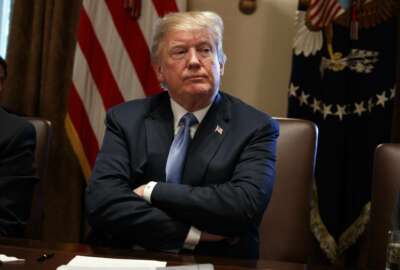
GSA-OPM set March 2019 timeline to complete initial merger
GSA released a request for information seeking help from contractors to support union of OPM’s HR Solutions office into the Federal Acquisition Service.
Best listening experience is on Chrome, Firefox or Safari. Subscribe to Federal Drive’s daily audio interviews on Apple Podcasts or PodcastOne.
September will mark 13 years since the General Services Administration merged the Federal Technology Service and the Federal Supply Service to make the Federal Acquisition Service.
 It’s a good time to remember what GSA went through in 2005 because once again, the agency is going down a similar path of trying to bring employees, their cultures and the services together. GSA is implementing the Trump administration’s proposal to bring the HR Solutions office at the Office of Personnel Management into FAS.
It’s a good time to remember what GSA went through in 2005 because once again, the agency is going down a similar path of trying to bring employees, their cultures and the services together. GSA is implementing the Trump administration’s proposal to bring the HR Solutions office at the Office of Personnel Management into FAS.
Back in 2005, GSA hired a contractor to help with the merger, chose leaders of the organizations to develop and implement a plan, received congressional approval and then completed the blending of the two organizations.
Today, GSA is following a comparable playbook. The agency first named Mary Davie, the deputy commissioner of FAS, to lead the planning effort. Now, GSA is looking for vendor help. It released a request for information last week seeking feedback across five broad areas.
“This is a very ‘GSA’ way of going about things to hire contractors and get recommendations,” said one former OPM official, who also is familiar with GSA and who requested anonymity because they did not get permission to speak to the press. “Part of the reason for needing a help is OPM doesn’t have the acumen to support this merger.”
The RFI also gives the first timeline for the merger. GSA said it expects the vendor to complete its work, which includes the rebadging of 462 employees in HRS and other actions, by March 30, 2019 to prepare for operations day one, which is scheduled for later in the spring. By 2020, GSA said it expects to complete the full merger.
“Contractor support for this effort is envisioned as an extension of the GSA/OPM task force, to support the transition and transformation activities,” the RFI states. “The scope of this initial effort includes: Supporting the planning and execution of the initial transition of the HRS organization and personnel into GSA; optimizing services and costs, improving alignment with GSA offices and functions and identifying opportunities to reduce duplication and overlap; and identifying further opportunities to transform the delivery of services that today comprise HRS and other, related services currently offered today by OPM and GSA.”
Responses to the RFI are due Aug. 17 and GSA said it expects to release a final solicitation before Sept. 30.
OPM-GSA merger makes sense
The eventual contractor will have its work cut out for them as former OPM and GSA officials say like any merger, there are culture and process obstacles that will need to be addressed.
“I think that contractors are very good [at] being objective listeners and facilitators of communications, but internally people have to want to listen,” the source said. “A contractor is not going to change what a federal employee has been living with for years and years. That will have to be driven by internally by leadership. They will have to believe in it.”
A government source with knowledge of OPM said moving some parts of HRS into GSA make sense for several reasons. The source, who requested anonymity because their current agency didn’t give them permission to talk to the press, said OPM already transferred the contracting capabilities of HRS to GSA to run the $11.5 billion Human Capital and Training Solutions (HCATs) multiple award contract. In fact, as a bit of an aside, it’s interesting that GSA and OPM also announced last week they were reducing the fee under HACTs to 0.75 percent from 2 percent as a way to make the contract more competitive and less costly than the schedules program.
Without a doubt over the last two years, HCATs has not lived up to expectations. So dropping the fee is an attempt to make the contract more attractive over the last two months of 2018 and into 2019.
The source said it also makes sense for GSA to take over the shared services that HRS provides USAJobs.gov, USAstaffing.gov and other related systems.
“Probably the hardest overall issue will be figuring out the cost recovery model. In the past, the training and management assistance (TMA) covered a lot of the costs for the rest of the HRS organization. When TMA integrated with GSA [through HCATs] that model was not sustainable in setting fees,” the government source said. “My guess is the other HRS programs probably have questionable financials now. GSA will likely consider each of these HRS components on a standalone basis and that will likely lead to a hard look at staffing and making investment decisions based on profitability versus an OPM culture that prioritizes HR programs, even unprofitable ones, and carrying people, even unproductive ones.”
At the same time, however, figuring out where HRS’s traditional training efforts such as the Federal Executive Institute, or its fee-based consulting services for human resources strategies and development would fit inside GSA is not as clear.
“One of things they are trying to do is make a case for the value proposition for why they would do this so it will help to have a third party do that work,” the source said. “What’s interesting to me is there have been opportunities for OPM and GSA to partner before. But it was not until HCATs that they made it work. OPM really takes an OPM-centric view and in the past didn’t see themselves as shared services provider, but rather as doing their mission. In a sense, they weren’t excited for shared services and may have missed some opportunities early on. Now that the merger is actually happening, GSA and OPM will have to deal with the culture change that comes with any big change like this one.”
OPM heading toward a culture clash?
The first source agreed that OPM is a unique place compared to GSA.
Latest Reorganization News
One way GSA is trying to address these culture challenges is by bringing in David Vargas, the former OPM director of the HR Line of Business and acting chief information officer and deputy CIO.
One industry expert, who also requested anonymity because their company does business with both GSA and OPM, said the merger is concerning for several reasons.
First, by adding HRS from OPM, GSA becomes that much bigger of an agency and will play a larger role in other agencies day-to-day so what’s the impact of those changes across government.
“The government needs to focus on decentralizing and distributing key OPM authorities out to the agencies,” the source said. “The track record of federal HR shared services is poor and has increased costs and added layers of inefficiency instead of the other way around – how does this help? What’s the business case for it? What does this do to free agencies to access better technologies to improve talent acquisition and talent management business processes and outputs inside the federal hiring agency?”
Read more of the Reporter’s Notebook
Copyright © 2025 Federal News Network. All rights reserved. This website is not intended for users located within the European Economic Area.
Jason Miller is executive editor of Federal News Network and directs news coverage on the people, policy and programs of the federal government.
Follow @jmillerWFED






